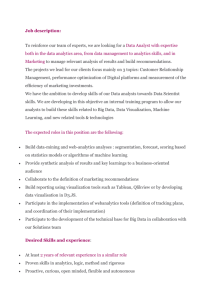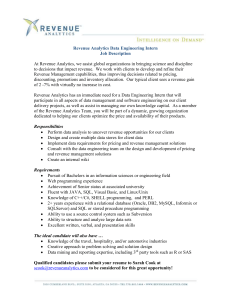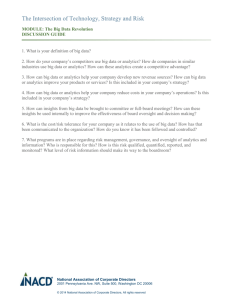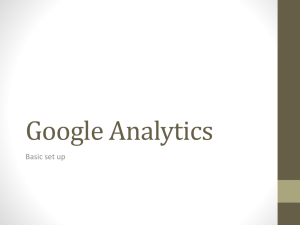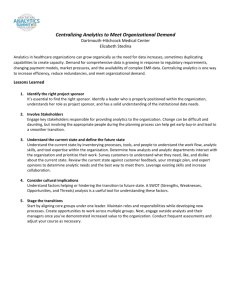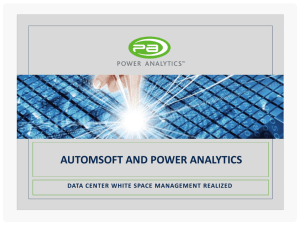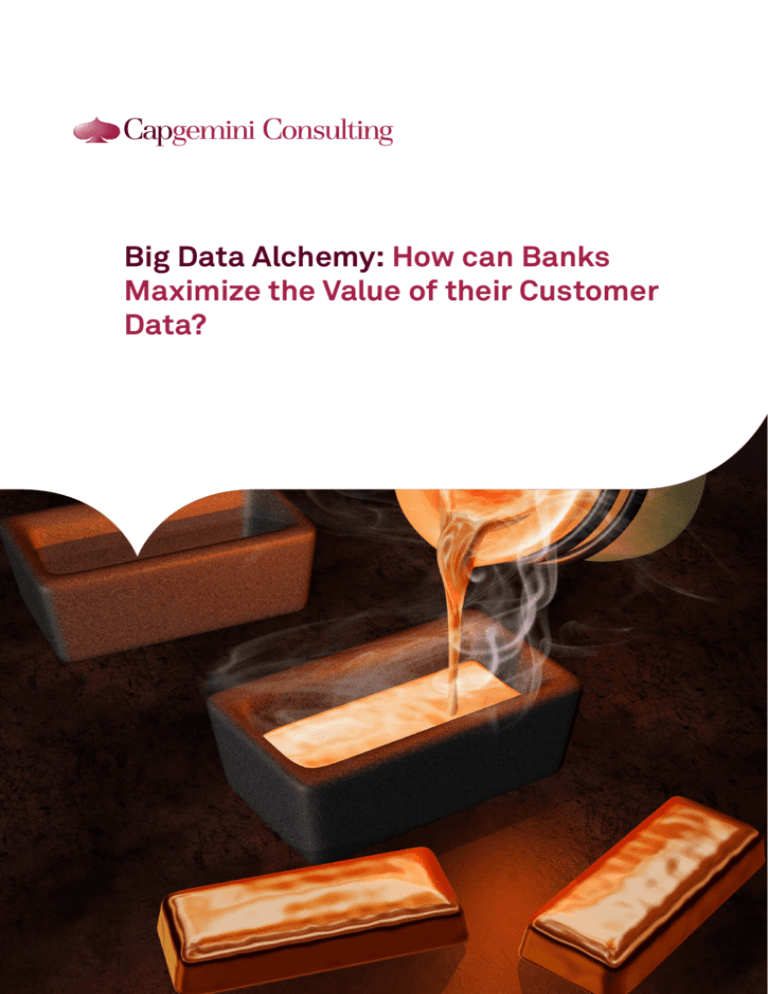
Big Data Alchemy: How can Banks
Maximize the Value of their Customer
Data?
Banks Have Not Fully Exploited
the Potential of Customer Data
Banks are Struggling to
Profit from Increasing
Volumes of Data
60% of financial
institutions in North
America believe that big
data analytics offers a
significant competitive
advantage and 90% think
that successful big data
initiatives will define the
winners in the future.
More than 70% of banking executives
worldwide say customer centricity is
important to them1. However, achieving
greater customer centricity requires a
deeper understanding of customer needs.
Our research indicates that only 37% of
customers believe that banks understand
their needs and preferences adequately
(see Figure 1).
frequent use of web and mobile channels
has led to a steady increase in the number
of customer interactions and, as a result,
increasing volume of customer data.
However, banks are only using a small
portion of this data to generate insights
that enhance the customer experience.
For instance, research indicates that less
than half of banks analyze customers’
external data, such as social media
activities and online behavior. Further, only
29% analyze customers’ share of walleta,
one of the key measures of a bank’s
relationship with its customers2.
This may be surprising given the
increasing volume and variety of data that
banks have about their customers. The
Figure 1: Customer Satisfaction across Five Core Areas of the Customer–Bank Relationship
Satisfied
% of respondents
Not Satisfied
43%
37%
Unsure
43%
47%
45%
43%
13%
16%
Knowledge of Customer
Product-Channel Fit
12%
Intimacy and Relationship Building
36%
44%
44%
51%
12%
Consistent Multi-Channel Experience
13%
Trust and Confidence
Source: Capgemini and EFMA, Retail Banking Voice of the Customer Survey, 2013.
a) Customers’ share of wallet is the percentage of financial services products customers have with a particular bank relative to all of the financial services products they hold.
2
Only 37% of banks have
hands-on experience
with live big data
implementations, while
the majority of banks are
still focusing on pilots
and experiments.
It is certainly strange given that the value
of big data is clear to business leaders
across the financial services industry.
Over 60% of financial institutions in North
America, for instance, believe that big data
analytics offers a significant competitive
advantage. Additionally, over 90% believe
that successful big data initiatives will
determine the winners of the future3.
However, knowledge of the impact of big
data has not translated to on-the-ground
investments. For instance, only 37% of
banks have hands-on experience with
live big data implementations, while the
majority of banks are still focusing on
pilots and experiments (see Figure 2).
In the next section, we examine some of
the reasons for this gap between the clear
case for action and the will to achieve it.
Figure 2: Big Data Adoption Levels in Banks
Expanding
37%
25%
38%
Deploying
12%
Exploring
25%
63%
Experimenting
Big data maturity levels (% of respondents)
Source: Microsoft and Celent, How Big is Big Data: Big Data Usage and Attitudes among North American
Exploring
Experimenting
Deploying
Expanding
Financial Services
Firm, March 2013.
3
Why are Banks Unable to Exploit Big Data?
Our research shows that ‘organizational
silos’ are the biggest barrier to success
in big data. Dearth of analytics talent, high
cost of data management, and a lack of
strategic focus on big data are also major
stumbling blocks (see Figure 3). Finally,
privacy concerns – which are high on
many bank executives’ agendas – are
also a significant issue.
Silos of Data Block a Single
Customer View
Customer data typically resides in silos
across lines of business or is distributed
across systems focused on specific
functions such as CRM, portfolio
management and loan servicing. As such,
banks lack a seamless 360-degree view of
the customer. Further, many banks have
inflexible legacy systems that impede
data integration and prevent them from
generating a single view of the customer.
For instance, Deutsche Bank embarked
on a big data project to analyze a large
amount of unstructured data, but faced
difficulties in the extraction of data from
legacy systems, and their integration with
big data systems (see insert on Page 5).
Organizational silos
constitute the top barrier
to success in big data.
Figure 3: Key Impediments to Big Data Success
What are your organization’s three biggest impediments to using big data for effective decision-making (select up to three)?
Too many "silos" - data is not pooled
for the benefit of the entire organization
57%
44%
Time taken to analyze large data sets
40%
Shortage of skilled people for data analysis
Big data is not viewed sufficiently
strategically by senior management
34%
Unstructured content in big data is
too difficult to interpret
33%
The high cost of storing and analyzing
large data sets
Big data sets are too complex to collect
and store
24%
17%
% of respondents
Source: Capgemini and the Economist Intelligence Unit, The Deciding Factor: Big Data and Decision-making, 2012.
4
The Skills and Development
Gap Needs Closing
Banks need new skill sets to benefit
from big data analytics. New data
management skills, including
programming, mathematical, and
statistical skills go beyond what is required
for traditional analytics applications. For
instance, ‘data scientists’ need to be
not only well versed in understanding
analytics and IT, they should also have
the ability to communicate effectively
with decision makers. However, this
combination of skills is in short supply4.
Three-quarters of banks do not have the
right resources to gain value from big
data5. Banks also face the challenge of
training end-users of big data, who may
not be data experts themselves but need
to use data to enhance decision-making.
Lack of Strategic Focus:
Big Data Viewed as Just
Another ‘IT Project’
Big data requires new technologies
and processes to store, organize, and
retrieve large volumes of structured
and unstructured data. Traditional data
management approaches followed
by banks do not meet big data
requirements. For instance, traditional
approaches hinge on a relational data
model where relationships are created
inside the system and then analyzed.
However, with big data, it is difficult to
establish formal relationships with the
variety of unstructured data that comes
through. Similarly, most traditional data
management projects view data from
a static and/or historic perspective.
However, big data analytics is largely
aimed to be used in a near real-time
basis. While most IT projects are driven
by the twin facets of stability and scale,
big data demands discovery, ability to
mine existing and new data, and agility6.
Consequently, by taking a traditional ITbased approach, organizations limit the
potential of big data. In fact, an average
company sees a return of just 55 cents
on every dollar that it spends on big data7.
Privacy Concerns Limit the
Adoption of Customer Data
Analytics
The use of customer data invariably
raises privacy issues8. By uncovering
hidden connections between seemingly
unrelated pieces of data, big data
analytics could potentially reveal sensitive
personal information. Research indicates
that 62% of bankers are cautious in their
use of big data due to privacy issues9.
Further, outsourcing of data analysis
activities or distribution of customer data
across departments for the generation
of richer insights also amplifies security
risks. For instance, a recent security
breach at a leading UK-based bank
exposed databases of thousands of
customer files. Although this bank
launched an urgent investigation, files
containing highly sensitive information —
such as customers’ earnings, savings,
mortgages, and insurance policies —
ended up in the wrong hands10. Such
incidents reinforce concerns about data
privacy and discourage customers from
sharing personal information in exchange
for customized offers.
So how can banks effectively overcome
these challenges? What are some of the
key areas that they should focus on?
In the next section, we discuss some
starting points for banks in their big data
journey.
An average company sees
a return of just 55 cents on
every dollar that it spends
on big data.
Big Data Plans at Deutsche Bank Held Back due to Legacy Infrastructure
Deutsche Bank has been working on a big data implementation since the beginning of 2012 in an attempt to analyze all of
its unstructured data. However, problems have arisen while attempting to unravel the traditional systems – mainframes and
databases, and trying to make big data tools work with these systems.
The bank has been collecting data from the front end (trading data), the middle (operations data) and the back-end (finance
data). Petabytes of this data are stored across 46 data warehouses, where there is 90% overlap of data. It is difficult to unravel
these data warehouses that have been built over the last two to three decades. The data integration challenge and the significant
investments made by the bank in traditional IT infrastructure pose a key question for the bank’s senior executives – what do
they do now with their traditional system? They believe that big, unstructured and raw data analysis will provide important
insights, mainly unknown to the bank. But they need to extract this data, streamline it and build traceability and linkages from
the traditional systems, which is an expensive proposition.
Source: Computerworld UK, Deutsche Bank: Big data plans held back by legacy systems, February 2013.
5
How Can Banks Realize Greater
Value From Customer Data?
Most banks have not focused significant
energy on using analytics to enhance
customer experience. Our survey with the
EFMA indicates that risk management
has been a high-priority focus area for
most banks, mainly to comply with
regulatory requirements, while customer
analytics has largely been neglected (see
Figure 4)11.
Customer Analytics has
Proven Benefits from
Acquisition to Retention
Processes
Research showed that banks that
apply analytics to customer data have
a four-percentage point lead in market
share over banks that do not. The
difference in banks that use analytics to
understand customer attrition is even
more stark at 12-percentage points12.
We believe banks can maximize the value
of their customer data by leveraging big
data analytics across the three key areas
of customer retention, market share
growth and increasing share of wallet (see
Figure 5).
Banks that apply
analytics to customer
data have a fourpercentage point lead in
market share over banks
that do not.
Big Data Analytics Helps Maximize
Lead Generation Potential
Big data solutions can help banks generate
leads for customer acquisition more
effectively. Take the case of US Bank,
Figure 4: Banks have Limited Focus and Capabilities around Customer
Analytics
High
Risk Management
Financial
Reporting
Bank’s Self-Assessed Capabilities
Customer Data Analytics
is a Low Priority Area for
Banks
Marketing
Analytics
Customer Analytics
Pricing
Low
Low
Fraud
Analytics
Portfolio
Analytics
Sales
Analytics
Channel
Analytics
Bank’s Current Priorities
High
Source: Capgemini and EFMA, World Retail Banking Report, 2013.
the fifth largest commercial bank in the
US. The bank wanted to focus on multichannel data to drive strategic decisionmaking and maximize lead conversions.
The bank deployed an analytics solution
that integrates data from online and offline
channels and provides a unified view of
the customer. This integrated data feeds
into the bank’s CRM solution, supplying
the call center with more relevant leads.
It also provides recommendations to the
bank’s web team on improving customer
engagement on the bank’s website. As a
result, the bank’s lead conversion rate has
improved by over 100% and customers
receive an enhanced and personalized
experience. The bank also executed three
major website redesigns in 18 months,
using data-driven insights to refine
website content and increase customer
engagement13.
Advanced Analytics Improves Credit
Risk Estimation by Exploring
Diverse Datasets
Assessing risks and setting the right
prices are key success factors in the
competitive retail banking market.
Existing scoring methodologies, mainly
FICO scoresb, assess credit worthiness
based solely on a customer’s financial
history. However, in order to ensure a
more comprehensive assessment, credit
scores should also include additional
variables such as demographic, financial,
employment, and behavioral data. By
using advanced predictive analytics
based on these additional data points,
banks can significantly enhance their
credit scoring mechanisms.
b) FICO score is the most widely used credit score model in the US. It takes into account factors in a person’s financial history such as payment history, credit utilization,
length of credit, types of credit used, and recent searches for credit.
6
For instance, although ‘current account’
balance levels and volatility are good
indicators of financial robustness and
stability, transaction drill-down analysis
provides
in-depth
insights
about
customers. It enables the segmentation
of customers based on spending
behavior. Several start-ups are also
leveraging social network data to score
customers based on credit quality. These
include Zest Finance and Kreditech14.
Other startups such as LendUp and
Lendo even provide loan services based
on social network data15.
‘Next Best Action’
Analytics Models Unlock
Opportunities to Drive Top
Line Growth
From ‘next best offer’ to cross-selling
and up-selling, the insights gleaned
from big data analytics allows marketing
professionals to make more accurate
decisions. Big data analytics allows
banks to target specific micro customer
segments by combining various data
points such as past buying behavior,
demographics, sentiment analysis from
social media along with CRM data. This
helps improve customer engagement,
experience and loyalty, ultimately leading
to increased sales and profitability.
At US Bank, analytics
enabled a single customer
view across online and
offline channels, which
improved the bank’s lead
conversion rate by over
100%.
In another instance, a European bank
built a ‘propensity to save’ model that
predicts the probability of its customer
base to invest in savings products, which
in turn leads to increased cross-selling.
The input to this model included data
sets of 1.5 million customers with over 40
variables. The analytics team tested over
50 hypotheses through logistic regression
propensity models to calculate the
probability of savings for each customer.
The pilot branches where this model was
implemented witnessed a 10x increase in
sales and a 200% growth in conversion
rate over a two-month period compared
to a reference group17.
Big Data Analytics Helps
Banks Limit Customer
Attrition
A mid-sized European bank used data
sets of over 2 million customers with
over 200 variables to create a model that
predicts the probability of churn for each
customer. An automated scorecard with
multiple logistic regression models and
decision trees calculated the probability of
churn for each customer. Through early
identification of churn risks, an outflow of
nearly 30 million per year was avoided18.
Figure 5: How can Big Data Analytics Help Banks Maximize Value from
Customer Data?
Acquire Customers
Grow Share of Wallet
Improve Credit Risk Estimation
Predictive Analytics can Improve
Conversion Rates by Seven Times
and Top-line Growth Ten-fold
We studied the impact of using advanced,
predictive analytics on marketing
effectiveness for a leading European
bank. The bank shifted from a model
where it relied solely on internal customer
data in building marketing campaigns,
to one where it merged internal and
external data sets and applied advanced
analytics techniques to this combined
data set. As a result of this shift, the bank
was able to identify and qualify its target
customers better. In fact, conversion
rates of prospects increased by as much
as seven times16.
Drive Efficiency of Marketing
Programs
Maximize Lead Generation Potential
Increase Sales Through Predictive
Analysis
Big Data Analytics
Retain Customers
Limit Customer Attrition
Improve Customer Satisfaction
Source: Capgemini Consulting analysis.
7
How Can Banks Realize Greater Value
From Customer Data?
Acquire New Customers
Leading European bank
Advanced analytics increased
the conversion of prospects by
7 times
Conventional Analytics
(Internal data)
Advanced Analytics
(Internal data and External data)
Drive Share of Wallet
European bank
10x increase in sales and
growth in
200% conversion rate
for the product in scope
The data input included
1.5 Mn customer data
across 40 variables
Limit Customer Attrition
Mid-sized bank
A
C
Analyzed over
2 million customers
across 200+ variables
8
B
D
Developed automated
scorecards and multiple
logistic regression models
and decision trees
Early identification of
cancellation risks helped
avoid an outflow of
about €30 Million
Bank of America Leverages Big Data Analytics to Deliver Consistent
Customer Experience and Detect Risks Early
Needs or Events-Based Marketing
Bank of America is focusing on big data with an emphasis on an integrated approach to customers and internal operations.
The key objective of its big data efforts is understanding the customer across all channels and interactions, and presenting
consistent, appealing offers to well-defined customer segments. For example, the bank utilizes transaction and propensity
models to determine which of its primary relationship customers may have a credit card, or a mortgage loan that could benefit
from refinancing. When the customer accesses the bank’s online channel, calls a call center, or visits a branch, that information is
available to the online app, or the sales associate to present the offer. The bank has launched a program called ‘BankAmeriDeals’,
which provides cash-back offers to holders of the bank’s credit and debit cards based on analyses of where they have made
payments in the past.
Risk Management
The bank moved from a shared-services data modeling environment to a dedicated ‘Grid Computing’ platform to drive operational
efficiency by early detection of high-risk accounts. The initiative is benefiting the bank in several ways, such as reducing its loan
default calculation time for a mortgage book of more than 10 million loans from 96 hours to just four. The bank is also able to
process ad hoc jobs at three times the speed of the previous environment.
Governance Structure
The bank modified its organizational structure in line with big data initiatives. The bank historically employed several quantitative
analysts, but in order to support its big data initiatives, the bank consolidated dispersed analytics talent. The bank also set up
matrix reporting lines from its analytics teams to a central analytics group as well as business units. This has improved visibility
and reusability of initiatives along with providing customized services specific to a function or a business unit.
Source: International Institute for Analytics and SAS, “Big Data in Big Companies”, May 2013.
Given that there are numerous avenues for the application of customer data analytics, where and how should banks begin? In the next
and concluding section, we present a structured approach for banks to industrialize their big data efforts across the organization.
9
How Can Banks Scale-up to the Next Level of
Customer Data Analytics?
Transformation across
Culture, Capabilities and
Technology is Critical for
the Success of Big Data
Initiatives
In order to graduate to higher levels of
maturity in customer data analytics, banks
will need to build the right organizational
culture and back it up with the right skill
sets and technological components (see
Figure 6).
Drive a Shift from a ‘Data as an ITasset’ to a ‘Data as a Key Asset for
Decision-Making’ Culture
Effective big data initiatives require
cultural changes within the organization
and a concerted shift towards a datadriven behavior. To drive successful big
data programs, banks should strive
towards full executive sponsorship for
analytics initiatives, develop and promote
a company-wide analytics strategy,
and embed analytics into core business
processes. In essence, banks need
to graduate towards a model where
analytics is a company-wide priority and
an integral element of decision-making
across the organization.
recruitment process to attract analytics
talent. Further, disparate analytics teams
should be consolidated into an Analytics
Centre of Excellence (CoE) that promotes
the sharing of best practices and supports
skills development. Banks must also
invest in continually training their analytics
staff on new tools and techniques. Finally,
specialized training programs should be
developed for line of business personnel,
to train them in the use of analytics to
enhance decision-making.
Develop Analytics Talent with a
Targeted Recruitment Process and
Continual Training Programs
As a first step towards building expertise
in customer data analytics, banks
will need to establish a well-defined
Figure 6: Roadmap to Building Analytics Maturity
Level of Maturity
Beginner
Culture
Capabilities &
Operating Model
Data
Sample Applications of
Customer Data Analytics
Source: Capgemini Consulting.
10
Expert
Preliminary analytics strategy,
but little buy-in from leadership
Analytics used to understand issues,
develop data-based options across
the business
Full executive sponsorship of
analytics
Pockets of reporting and analysis
capability
Well-defined recruitment process
to attract analytics talent
Analytics Centre of Excellence
to promote best practices
Dispersed talent
Budget for analytics training
Strategic partnerships for
supplementary analytics skills
No defined data infrastructure
Data available for existing and
potential customers
Conflicting, informal and dispersed
data
Poor data governance
Technology
Proficient
Basic data reporting using mainly
spreadsheet based tools
Mass/random targeting of
customers to increase product
profitability using basic product
eligibility criteria
Most data is still unstructured and
internal
Use of some statistical and
forecasting tools
Coherent procedures for data
management
Basic profiling of customer base
with customized analysis on
drivers of purchase of each
product individually
Internal, external and social media
data is merged to build an integrated
and structured dataset
Established, robust master data
management framework for
structured and unstructured data
sets
Analyzing customer behavior
across channels to predict interest
areas; developing personalized
products and services
Establish a Strong Data
Management Framework for
Structured as well as Unstructured
Data
The quality, accuracy, and depth of
customer data determine the value
of customer insights. Consequently,
banks will need to establish robust data
management frameworks to formalize the
collection, storage and use of structured
as well as unstructured data. Additionally,
banks must graduate to more advanced
analytics techniques such as predictive
and prescriptive analytics that enable
more precise modeling of customer
behavior. These in turn will drive increased
cross-selling opportunities, pricing
optimization and targeted offerings.
Move Up the Analytics
Maturity Curve with Three
Sequential Controlled
Steps
Big data initiatives are typically time and
resource-intensive. To pave the way for a
smooth implementation, we recommend
a three-step approach that begins with
an assessment of existing analytics
capabilities (see insert on Page 12) and
is followed by the launch of pilot projects,
which are subsequently expanded into
full-scale organization-wide programs
(see Figure 7).
A capability assessment at the beginning
of a big data program will provide banks
with a view of analytics capability gaps
that are holding them back, such as
untapped data assets and key external
data sets that are required to create a
holistic view of the customer. With a
clearer view of capability gaps, banks will
be better placed to prioritize their actions
and investments.
Following a capability assessment, we
recommend that banks undertake their
transformation journey in controlled
steps, rather than in a giant leap. As such,
banks should first identify and focus on
a few small pilot projects, and use these
as opportunities to test the efficacy of
new analytics tools and techniques. For
instance, Rabobank, the Netherlandsbased banking and financial services
company, started its big data initiative
with a clear goal – to improve efficiency
in business processes by analyzing
customer data (see insert on Page 13).
Based on the learning from a pilot project,
banks can modify how they manage
big data, add more complexity to use
cases and subsequently rollout big data
initiatives across the organization.
Figure 7: Key Steps to Effective Big Data Initiatives
Stage 3
Stage 2
Stage 1
Extend Big Data Initiatives
across Organization
Begin with a Pilot
Big Data Use Case
Assess Big Data
Analytics Capabilities
Source: Capgemini Consulting.
11
Assess Your Big Data Maturity
For each answer, select the option that you most closely relate with your organization
1
3
5
Do you have the right culture for driving big data analytics?
Would you describe your organisation as datadriven?
How important will big data be to decision-making
in your organisation in the next five years?
How do your business and IT teams operate?
No, we largely rely on intuition
We are not yet impacted
We use limited analytics to Collection and analysis of data
develop data-based decision underpins our business strategy
options for the business
and day-to-day decision making
To a limited extent
Both teams operate
Business and IT teams come
separately, with the business
together, but only for key
team giving guidelines and IT
projects driven from the top
implementing
We expect big data to be a key
component of decision-making
going forward
We
have
joint
steering
committees where business
and IT teams work together as
one team
Does your organization have the capabilities for benefiting from big data?
We have a centralized analytics
We have analytics teams in team that constantly invests in
different business units who skill upgradation and works with
largely work independently
smaller capability groups across
the company
What is your investment level in analytics
capabilities?
We largely use adhoc
tools based on individual
experience with data analysis
How do you develop big data analytics capabilities?
We rely on a mix of in-house
We rely solely on in-house and external trainings from
trainings
third-party institutions such
as universities
We have multiple partnerships
with specialist analytics firms
that help in building long-terms
capabilities in-house
Do you have the right data that big data analytics demands?
How structured are your datasets?
How do you deal with growing data volume?
We don’t have a defined data
policy
We rely on structured internal
data sets, and combine them
We have data availability,
with external data sets. We
but in silos, and most data is
then integrate them with social
limited to existing and some
media to create a merged and
potential customers
integrated dataset that gives us
a single view of the customer
We haven’t developed a
defined policy on handling
growing datasets
For those datasets that we
have been tracking, we rely
on historical growth volumes,
while factoring in additional
volume
from
external
datasets
We have well-defined systems
and policies to cope with the
explosion in datasets that we
are already seeing
Do you have the technology to ensure the success of big data Analytics?
We have a full suite of integrated
We use some big data tools
technology driven tools that
based on the dataset, but
enables us to do both predictive
haven’t standardized on their
and prescriptive analytics on
usage across the organization
customer data
What tools do you use for big data analytics?
We don’t use tools specific to
big data. We use traditional
tools that we have used for
analytics in the past
How do you manage your data sets?
We
have
some
data
Most teams within the
management guidelines, but
company manage data in
they are not fully implemented
their own formats
yet
Overall Score (0 - 45)
Big Data Maturity
Overall Score
<9: Beginner, 10-30: Proficient, >30: Expert
We have established, robust
master
data
management
framework for structured and
unstructured data sets
Rabobank Embarked on a Big Data Journey
by Adopting a ‘Start Small and Add More
Complexity Step-by-Step’ Strategy
Rabobank named big data as one of the 10 most important trends in their
2013 yearly report and started developing a strategy around it. They created a
list of 67 possible big data use cases, divided them into four categories – fix
organizational bottlenecks, improve efficiency in business processes, create new
business opportunities and develop new business models. For each of these
categories they measured IT impact, time required for implementation, and
business value proposition. The bank moved ahead with big data applications
for the improvement of business processes due to their low IT impact and the
possibility of a positive ROI.
Rabobank started with a few proof-of-concepts using only internal data. Later,
the bank extended the scope of its big data program to include web data (click
behavior), social network data, public data from government sources and macrotrend data. The bank built small clusters using open-source technology to test and
analyze unstructured data sets, which kept costs low and offered the scalability
to expand. A dedicated multidisciplinary team was setup to implement big data
use cases. The team experimented with small and short implementation cycles.
Implementation challenges remain the
biggest hurdles towards the effective
use of customer data analytics by banks.
While pilots deliver quick and measurable
results, banks need to concurrently lay
the foundations to effectively scale-up big
data initiatives. The key lies in adopting
a comprehensive approach, where
pilots are backed by a well-defined data
strategy and data governance model. The
first step towards such an approach lies
in altering traditional mindsets. Big data
initiatives must be perceived differently
from traditional IT programs. They must
extend beyond the boundaries of the IT
department and be embraced across
functions as the core foundation for
decision-making. Only then will banks be
able to make the best use of their vast
and growing repositories of customer
data.
One of the use cases at Rabobank involved analyzing criminal activities at ATMs.
Rabobank found that the proximity of highways, and the season and weather
conditions increased the risk of criminal activities. The bank also used big data
tools to analyze customer data to find the best locations for ATMs. Based on its
initial success with big data analytics, Rabobank is now focusing on addressing
more pressing big data issues around privacy concerns and data ownership.
Source: BigData-Startups.com, With Proof of Concepts, Rabobank Learned Valuable Big Data
Lessons, 2013.
13
References
1
SAP and Bloomberg Businessweek Research Services, “Banks Betting Big on Big Data and Real-Time Customer Insight”,
September 2013
2
BBRS 2013 Banking Customer Centricity Study, 2013
3
Microsoft and Celent, “How Big is Big Data: Big Data Usage and Attitudes among North American Financial Services Firms”,
March 2013
4
MIT Sloan Management Review and SAS, “How ‘Big Data’ is Different”, July 2012
5
Finextra Research, Clear2Pay, NGDATA, “Monetizing Payments: Exploiting Mobile Wallets and Big Data”, 2013
6
MIT Sloan Management Review and SAS, “How ‘Big Data’ is Different”, July 2012
7
Wikibon, “Enterprises Struggling to Derive Maximum Value from Big Data”, September 2013
8
O’Reilly Media, “EBook: Big Data Now”, October 2012
9
Finextra Research, Clear2Pay, NGDATA, “Monetizing Payments: Exploiting Mobile Wallets and Big Data”, 2013
10 Mail Online, “Exposed: Barclays account details for sale as ‘gold mine’ of up to 27,000 files is leaked in worst breach of bank
data EVER”, February 2014
11 Capgemini, “World Retail Banking Report”, 2013
12 Aberdeen, “Analytics in Banking”, July 2013
13 US Bank Case Study by Adobe, 2012
14 The Economist “Lenders are Turning to Social Media to Assess Borrowers”, February 2013
15 Slate, “Your Social Networking Credit Score”, January 2013
16 Capgemini Consulting analysis
17 Capgemini Consulting analysis
18 Capgemini Consulting analysis
Authors
Jean Coumaros
Head of Financial Services Global
Market Unit
jean.coumaros@capgemini.com
Stanislas de Roys
Head of Banking Market Unit
stanislas.deroys@capgemini.com
Laurence Chretien
Vice President, Big Data and Analytics
laurence.chretien@capgemini.com
Jerome Buvat
Head of Digital Transformation Research
Institute
jerome.buvat@capgemini.com
Subrahmanyam KVJ
Manager, Digital Transformation
Research Institute
subrahmanyam.kvj@capgemini.com
Vishal Clerk
Senior Consultant, Digital
Transformation Research Institute
vishal.clerk@capgemini.com
Olivier Auliard
Chief Data Scientist, Capgemini
Consulting France
oliver.auliard@capgemini.com
Digital Transformation
Research Institute
dtri.in@capgemini.com
The authors would also like to acknowledge the contributions of Ingo Finck from Capgemini Consulting Germany, Sebastien
Podetti from Capgemini Consulting France, Tripti Sethi from Capgemini Consulting Global, Steven Mornelli and Rajas Gokhale
from Capgemini Financial Services Global Business Unit and Roopa Nambiar and Swati Nigam from the Digital Transformation
Research Institute.
For more information contact
Global
Jean Coumaros
jean.coumaros@capgemini.com
Norway
Jon Waalen
jon.waalen@capgemini.com
United States
Jeff Hunter
jeff.hunter@capgemini.com
France
Stanislas de Roys
stanislas.deroys@capgemini.com
Germany/Austria/Switzerland
Titus Kehrmann
titus.kehrmann@capgemini.com
BeNeLux
Robert van der Eijk
robert.van.der.eijk@capgemini.com
Spain
Christophe Mario
christophe.mario@capgemini.com
United Kingdom
Keith Middlemass
keith.middlemass@capgemini.com
India
Natarajan Radhakrishnan
natarajan.radhakrishnan@capgemini.com
Sweden/Finland
Johan Bergstrom
johan.bergstrom@capgemini.com
Customer Value Analytics
Capgemini Consulting’s Customer value analytics solution identifies levers of profit improvement and growth across online and offline
channels for clients, leveraging customer behavioural and preference patterns. The solution is sector-specific, and has specific modules
developed for the Banking, Automotive & Insurance industries. The solution spans the entire customer journey, providing clients multiple
opportunities to drive their top line through increased acquisition, an expanding share of wallet, demand forecasting and reduction
of customer attrition. Several pre-built components like ready to use analytical platforms, proof of concept and data diagnostic
methodologies, pre-fabricated models and use cases allow for quick deployment in project delivery.
About Capgemini and the
Collaborative Business Experience
Capgemini Consulting is the global strategy and transformation
consulting organization of the Capgemini Group, specializing
in advising and supporting enterprises in significant
transformation, from innovative strategy to execution and with
an unstinting focus on results. With the new digital economy
creating significant disruptions and opportunities, our global
team of over 3,600 talented individuals work with leading
companies and governments to master Digital Transformation,
drawing on our understanding of the digital economy and
our leadership in business transformation and organizational
change.
With more than 130,000 people in over 40 countries, Capgemini
is one of the world’s foremost providers of consulting,
technology and outsourcing services. The Group reported 2013
global revenues of EUR 10.1 billion. Together with its clients,
Capgemini creates and delivers business and technology
solutions that fit their needs and drive the results they want. A
deeply multicultural organization, Capgemini has developed its
own way of working, the Collaborative Business ExperienceTM,
and draws on Rightshore®, its worldwide delivery model.
Find out more at:
http://www.capgemini-consulting.com/
Learn more about us at www.capgemini.com
Rightshore® is a trademark belonging to Capgemini
Capgemini Consulting is the strategy and transformation consulting brand of Capgemini Group. The information contained in this document is proprietary.
© 2014 Capgemini. All rights reserved.



